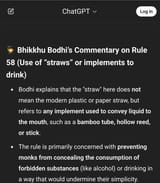Search Results
7/6/2025, 4:00:13 AM
>>24523866
>>24525033
1. **Avoidance of Hidden Alcohol Consumption**:
Monks could potentially disguise **fermented drinks** (which are prohibited) by sipping them discreetly through a tube or implement — making it look like plain water.
2. **Pretense or Worldliness**:
Using implements to drink could be seen as **luxurious**, overly refined, or imitative of lay customs — contrary to the monk’s ideal of simplicity and renunciation.
3. **Begging for Tools**:
Asking or receiving such a tool from a layperson might imply **attachment to convenience** or luxury, which the Vinaya seeks to avoid.
4. **Health Risks or Superstition**:
Some Vinaya rules were also to protect monks from health risks or suspicious behaviors (e.g., using certain tools seen as suspicious or unnecessary).
---
### **Conclusion**
So yes, **"straws" (in a primitive sense)** existed in the Buddha’s time, probably as **hollow reeds, bamboo tubes, or sticks**, not modern plastic straws.
The rule in **Bhikkhu Pāṭimokkha #58** prohibits receiving such an implement likely because it could:
* Be used to secretly consume alcohol or inappropriate liquids,
* Reflect unnecessary refinement or indulgence,
* Violate the monk’s code of simplicity.
It’s less about the tool itself, and more about the **intention, context, and perception** involved in using it.
Would you like to see the commentary (like *Samantapāsādikā*) on this rule as well?
>My post now
Almost everything is fake. The Pali is fake. The meanings are fake. The facts it gives are fake. The scholarly opinions are fake. It's all hallucination. If you ask it for a scholar's opinion, it gives a fake source:
>Bhikkhu Bodhi’s Commentary on Rule 58 (Use of “straws” or implements to drink)
>Bodhi explains that the "straw" here does not mean the modern plastic or paper straw, but refers to any implement used to convey liquid to the mouth, such as a bamboo tube, hollow reed, or stick.
Etc. I caused a hallucination, but they happen extremely frequently without any effort. It's just that an AI user frequently does not notice these hallucinations or rarely examines a text deeply enough.
>>24525033
1. **Avoidance of Hidden Alcohol Consumption**:
Monks could potentially disguise **fermented drinks** (which are prohibited) by sipping them discreetly through a tube or implement — making it look like plain water.
2. **Pretense or Worldliness**:
Using implements to drink could be seen as **luxurious**, overly refined, or imitative of lay customs — contrary to the monk’s ideal of simplicity and renunciation.
3. **Begging for Tools**:
Asking or receiving such a tool from a layperson might imply **attachment to convenience** or luxury, which the Vinaya seeks to avoid.
4. **Health Risks or Superstition**:
Some Vinaya rules were also to protect monks from health risks or suspicious behaviors (e.g., using certain tools seen as suspicious or unnecessary).
---
### **Conclusion**
So yes, **"straws" (in a primitive sense)** existed in the Buddha’s time, probably as **hollow reeds, bamboo tubes, or sticks**, not modern plastic straws.
The rule in **Bhikkhu Pāṭimokkha #58** prohibits receiving such an implement likely because it could:
* Be used to secretly consume alcohol or inappropriate liquids,
* Reflect unnecessary refinement or indulgence,
* Violate the monk’s code of simplicity.
It’s less about the tool itself, and more about the **intention, context, and perception** involved in using it.
Would you like to see the commentary (like *Samantapāsādikā*) on this rule as well?
>My post now
Almost everything is fake. The Pali is fake. The meanings are fake. The facts it gives are fake. The scholarly opinions are fake. It's all hallucination. If you ask it for a scholar's opinion, it gives a fake source:
>Bhikkhu Bodhi’s Commentary on Rule 58 (Use of “straws” or implements to drink)
>Bodhi explains that the "straw" here does not mean the modern plastic or paper straw, but refers to any implement used to convey liquid to the mouth, such as a bamboo tube, hollow reed, or stick.
Etc. I caused a hallucination, but they happen extremely frequently without any effort. It's just that an AI user frequently does not notice these hallucinations or rarely examines a text deeply enough.
Page 1
